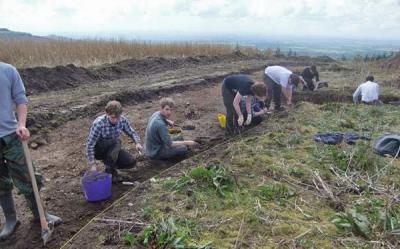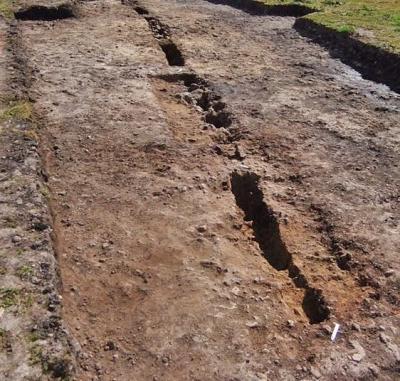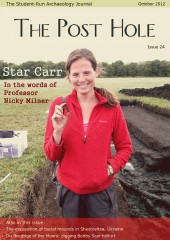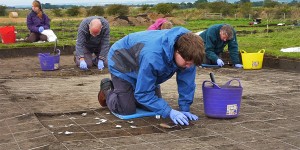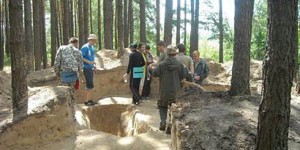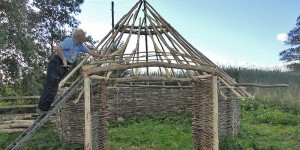Despite the fact that we are Archaeology Undergraduates, most first year students have never been on an archaeological excavation before, let alone had a full appreciation of what it would entail. As part of the course there is a compulsory module entitled ‘Archaeological Excavation’. The name is self-explanatory, and in the lead up to starting the dig all the various site leaders gave lectures trying to convince us that their site was the ‘most interesting’. At this point there appeared a divide amongst students that had previously gone unnoticed; the divide had two sides — historians and prehistorians. Whilst the historians were enticed by the promise of endless finds (at Gawthorpe Manor), the prehistorians were pulled in by the mystery and uncertainty of a site about which relatively little was known.
Boltby Scar has undergone excavations prior to the work that is now being conducted by the Landscape Research Centre (LRC). However, poor record keeping has meant that next to nothing has come from these endeavours, bar a sketch, some notes and some gold earrings (Powlesland 2009). The site of Boltby Scar is a scheduled monument (a monument protected by law as it is deemed to have archaeological significance); despite this classification, in 1961 unauthorised agricultural work involving a bulldozer destroyed integral parts of the site’s archaeology and history, including the total destruction of what is thought to have been a round barrow (Powlesland 2009).
The most recent excavations have aimed at uncovering new evidence that will allow for greater insight into what the site was used for, whilst also collecting environmental samples that will help date the site. In 2009, a team of volunteers and research specialists set to work at the site with the ambition of uncovering evidence that could lead to reconstructions of some aspects of the hillfort to enhance understanding of the occupation.
The excavations taking place at Boltby Scar this year had several key aims. Firstly, the team were attempting to learn more about what was suspected of being Iron Age and Early Bronze Age activity in the area. This would also include endeavouring to ascertain the relationship between the palisade (this is an enclosure or fence) and hillfort, and to find out if there was more than one entrance. The next aim was to uncover any activity (domestic or otherwise) related to the hillfort, or even pre-hillfort; whilst also determining whether one of the features previously identified is a long barrow, house or something else entirely (Powlesland 2012).
On our first day of excavation we found ourselves up at what for a student was a horrifically early hour (the rest of society call it 8am), followed a little while later by being herded up the side of a very steep hill. When we eventually reached the top, we found what was going to be our second home for the following three weeks. Ironically, on that very first day the weather was extremely warm, and misleading as it was not to remain as pleasant for the rest of our time at Boltby Scar.
We were set to work almost immediately, following brief introductions with our supervisors, and were handed buckets and trowels (and the more physically able of us, mattocks). Prior to our arrival at the site the trenches, which were to be the focus of the excavation, had been cleared by machinery, but this was done messily and they were haphazard. Therefore we were charged with the cleaning of the trenches. This primarily involved straightening the sections and clearing the bottom of the trench, so that features became more visible. Although this sounds a simple task, what became clear very quickly was that the ability to trowel well is something that can only be obtained through experience. During this we heard many subjective phrases about ‘the texture and colour of the soil’ and ‘the feel of the surface’. By the end of the three weeks we were also using these seemingly bizarre phrases ourselves! We worked on the clearing of the trenches for several days, something that became increasingly difficult with the steady deterioration of the weather.
After this part of the dig had been completed we began to work on excavating some of the features in the trench designated ‘AG’. The palisade enclosure ran right through this trench, and it was excavated at regular intervals in an attempt to track its progress and observe whether there had been a consistent method of construction (anon. nd.). For the most part this was a relatively straightforward process, as the clearing of the bottom of the trench and removal of topsoil etc. had uncovered the palisade so that it was clear which parts required excavation. Unfortunately the truncation of the site by a bulldozer meant that in one stretch the palisade disappeared from sight completely. This meant that the section needed to be excavated blind, something not usually done in archaeology, where the general rule is ‘if it can’t be seen then it won’t be excavated’. Despite this minor complication the palisade was successfully excavated, and by sheer chance uncovered a particularly interesting section, where there appeared to be three post pipes (these are holes that have a very precise form where the wood in the slot did not survive).
Whilst the palisade was being investigated some members of the group were excavating a ditch that ran alongside. Unfortunately this part of the excavation was never completed as bad weather later in the dig meant that the side of the ditch collapsed and it became too dangerous for excavation to continue.
In the same trench (AG), a previous excavation’s trench was also being excavated (anon. nd.). This previous excavation was carried out by a man called Wilmott during the antiquarian period. However the aim of Wilmott’s excavation had little to do with obtaining information about the era in which the archaeology occurred, but rather was to collect artefacts indicative of the era, for display or personal gratification. Wilmott also excavated the round barrow at the site and uncovered a pair of gold earrings. Due to the nature of archaeology at the time of Wilmott’s excavation there is little record of the work done. Hence the trenches he opened are being re-excavated (Powlesland 2009).
The round barrow also underwent excavation, following the trench that had been excavated previously by Wilmott (who left limited notes, in which he recorded a hearth, though no evidence of this has been found so far). A stone ring was uncovered, along with a few post holes, which may have been used to support some sort of construction. A coffin was also found though unfortunately because of the nature of the soil and the ground no organic remains survived, but it was evident from the stratigraphy and the colour of the soil that this was the case. Again, no skeletal remains were uncovered. Despite Wilmott claiming to have found the gold earrings in the barrow, no other such artefacts have been found. There were however an abundance of flints (arrow heads and blades) from within this area.
In trench AK a sub group were working towards excavating the rampart, and following the palisade enclosure to see if it continued that far back. Following the completion of the excavation we were all shown how to take section drawings, plans and how to complete finds and records sheets; which we continued to do for the last week of excavation. We were also taught how to input data on the palm pilots, to allow for quick and easy data processing.
Many of us who went to Boltby Scar had never taken part in an excavation prior to this one, and before we went to the site people were unsure of what to expect. Having now completed a dig, many people are keen to continue. In fact some of the group decided to return for an extra few days of excavation because they enjoyed the experience so much. Not long before we started at Boltby Scar, we were all informed by the site leader Dominic Powlesland that excavation “is the most fun you can have without taking your clothes off”, at the time this seemed a ridiculous statement, however, if asked now the majority of the group who worked at Boltby Scar would be very quick to agree.
Bibliography
- anon. nd. ‘Boltby Scar Exploration Blog’ http://boltbyscar.wordpress.com/. Accessed 27th June 2012
- Powlesland, D. (2009) ‘Boltby Scar Excavations: Interim Report October 2009’
http://www.landscaperesearchcentre.org/html/boltby_scar.html. Accessed 27th June 2012 - Powlesland, D. (2012) Boltby Scar 2012: ‘Research Design and Excavation Objectives’
http://thelrc.wordpress.com/2012/03/27/boltby-scar-excavations-2012/. Accessed 27th June 2012


